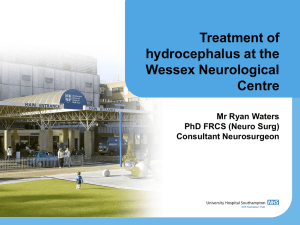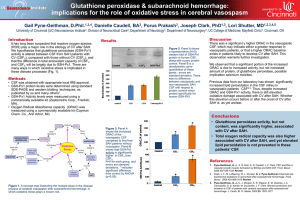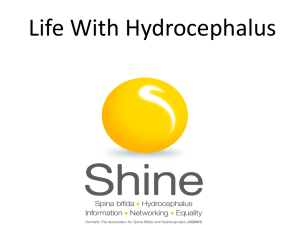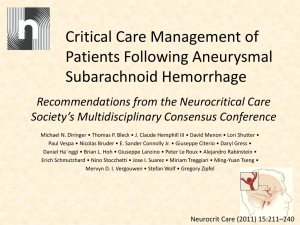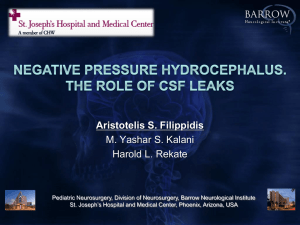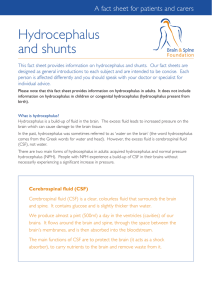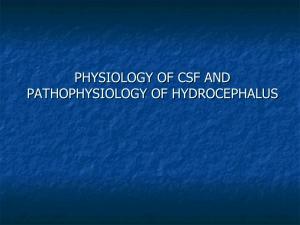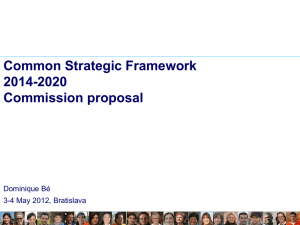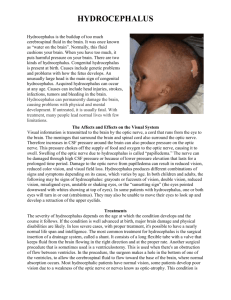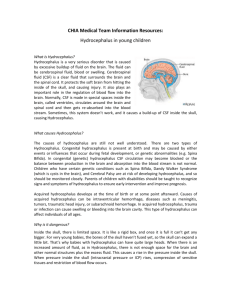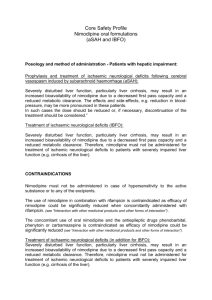APPENDIX Management of Potential Side Effects Blood Pressure
advertisement
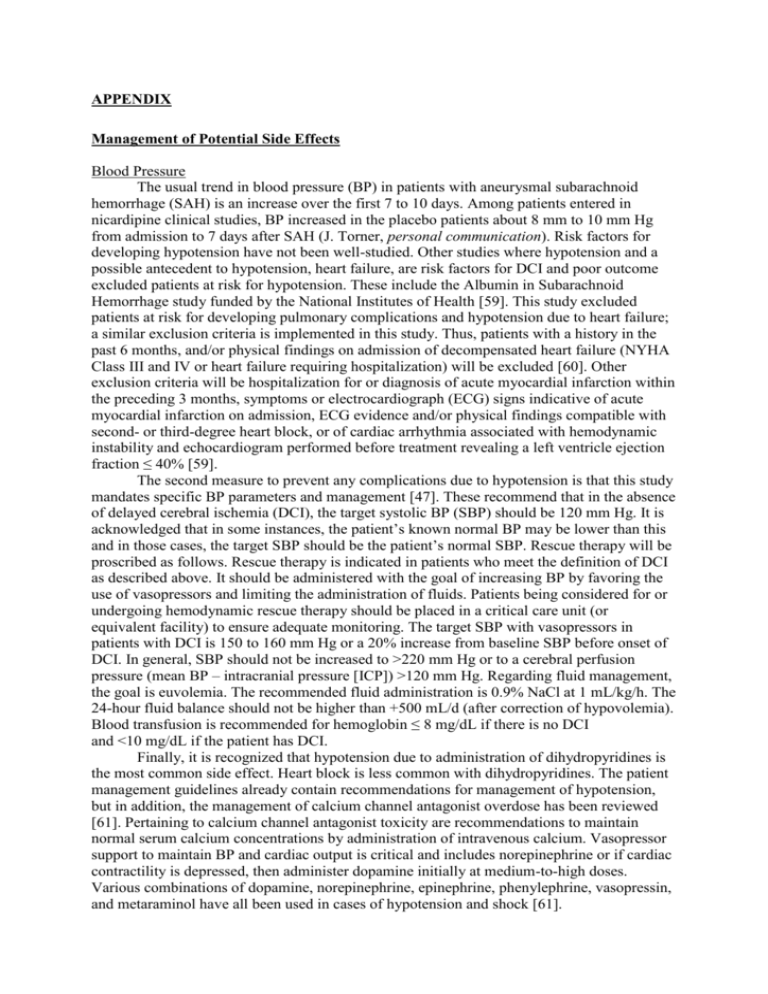
APPENDIX Management of Potential Side Effects Blood Pressure The usual trend in blood pressure (BP) in patients with aneurysmal subarachnoid hemorrhage (SAH) is an increase over the first 7 to 10 days. Among patients entered in nicardipine clinical studies, BP increased in the placebo patients about 8 mm to 10 mm Hg from admission to 7 days after SAH (J. Torner, personal communication). Risk factors for developing hypotension have not been well-studied. Other studies where hypotension and a possible antecedent to hypotension, heart failure, are risk factors for DCI and poor outcome excluded patients at risk for hypotension. These include the Albumin in Subarachnoid Hemorrhage study funded by the National Institutes of Health [59]. This study excluded patients at risk for developing pulmonary complications and hypotension due to heart failure; a similar exclusion criteria is implemented in this study. Thus, patients with a history in the past 6 months, and/or physical findings on admission of decompensated heart failure (NYHA Class III and IV or heart failure requiring hospitalization) will be excluded [60]. Other exclusion criteria will be hospitalization for or diagnosis of acute myocardial infarction within the preceding 3 months, symptoms or electrocardiograph (ECG) signs indicative of acute myocardial infarction on admission, ECG evidence and/or physical findings compatible with second- or third-degree heart block, or of cardiac arrhythmia associated with hemodynamic instability and echocardiogram performed before treatment revealing a left ventricle ejection fraction ≤ 40% [59]. The second measure to prevent any complications due to hypotension is that this study mandates specific BP parameters and management [47]. These recommend that in the absence of delayed cerebral ischemia (DCI), the target systolic BP (SBP) should be 120 mm Hg. It is acknowledged that in some instances, the patient’s known normal BP may be lower than this and in those cases, the target SBP should be the patient’s normal SBP. Rescue therapy will be proscribed as follows. Rescue therapy is indicated in patients who meet the definition of DCI as described above. It should be administered with the goal of increasing BP by favoring the use of vasopressors and limiting the administration of fluids. Patients being considered for or undergoing hemodynamic rescue therapy should be placed in a critical care unit (or equivalent facility) to ensure adequate monitoring. The target SBP with vasopressors in patients with DCI is 150 to 160 mm Hg or a 20% increase from baseline SBP before onset of DCI. In general, SBP should not be increased to >220 mm Hg or to a cerebral perfusion pressure (mean BP – intracranial pressure [ICP]) >120 mm Hg. Regarding fluid management, the goal is euvolemia. The recommended fluid administration is 0.9% NaCl at 1 mL/kg/h. The 24-hour fluid balance should not be higher than +500 mL/d (after correction of hypovolemia). Blood transfusion is recommended for hemoglobin ≤ 8 mg/dL if there is no DCI and <10 mg/dL if the patient has DCI. Finally, it is recognized that hypotension due to administration of dihydropyridines is the most common side effect. Heart block is less common with dihydropyridines. The patient management guidelines already contain recommendations for management of hypotension, but in addition, the management of calcium channel antagonist overdose has been reviewed [61]. Pertaining to calcium channel antagonist toxicity are recommendations to maintain normal serum calcium concentrations by administration of intravenous calcium. Vasopressor support to maintain BP and cardiac output is critical and includes norepinephrine or if cardiac contractility is depressed, then administer dopamine initially at medium-to-high doses. Various combinations of dopamine, norepinephrine, epinephrine, phenylephrine, vasopressin, and metaraminol have all been used in cases of hypotension and shock [61]. Hydrocephalus Hydrocephalus, defined by ventricular dilatation, can be seen in 20% to 28% of patients with SAH. The occurrence of hydrocephalus is related to the presence of intraventricular and subarachnoid blood and its presence increases mortality, particularly if left untreated. The increased mortality may be related to the presence of cerebral infarcts and decreased intravascular volume. Hydrocephalus will be measured by ventriculocranial ratio [62]. Acute hydrocephalus will be managed according to standard neurosurgical procedures. An external ventricular drain (EVD) will be inserted in patients in patients according to the standard-of-care at the study site. This can be an antibiotic or silver-containing catheter. The EVD will be removed at a time when the ICP is controlled and cerebrospinal fluid (CSF) drainage is not required to control the ICP. If it cannot be removed or if the patient develops symptomatic hydrocephalus after removal of the EVD; then, according to standard neurological practice, it is at the discretion of the treating physician to insert another EVD or to place a permanent CSF diversion shunt. Meningitis/Ventriculitis This will be defined as organisms present on CSF culture or the presence of one of the following signs and symptoms: fever higher than 38°C, new headache, new meningeal signs, cranial nerve signs, and at least one of the following: presence of an increased CSF pleocytosis, elevated protein and/or decreased glucose deemed not to be chemical meningitis or the usual pathological response of the CSF to SAH; or organisms seen on Gram’s stain of CSF [63]. If this is diagnosed, it will be treated with appropriate antibiotics by the treating physicians, with consultation from specialists in infectious diseases if deemed necessary. Elevated Liver Enzymes If elevated liver enzymes (increase in alkaline phosphatase or alanine aminotransferase >2 × upper limit of normal) develop, all hepatotoxic drugs or drugs metabolized by the cytochrome P450 system, such as paracetamol, valproic acid, levetiracetam, and barbiturates will be stopped or the dose reduced as much as possible. Investigations, such as abdominal ultrasound or CT scan will be done to rule out other causes of elevated liver enzymes. Liver enzymes and function will be monitored. The only other specific management would be exceptionally rare, but is to consider liver transplantation if fulminant acute liver failure develops. Renal Injury If there is evidence of renal injury (increase in serum creatinine >2 × baseline) then nephrotoxic drugs, such as aminoglycosides, ciprofloxacin, tetracycline, vancomycin and nonsteroidal anti-inflammatory drugs, will be stopped or the dose reduced as much as possible. Investigations, such as urinalysis, abdominal ultrasound and CT scan will be done to rule out other causes of renal dysfunction. Adequate blood volume and hydration and normal electrolytes will be maintained and renal function will be monitored. If the injury progresses, hemodialysis might be indicated and will be assessed in consultation with a nephrologist. Outcome Measures Safety and Tolerability Safety monitoring and grading used for evaluating adverse events will be based on the National Cancer Institute Common Terminology Criteria for Adverse Events (NCI CTCAE, Version 4.0). Hypotension defined as mean SBP <80 mm Hg, lasting over 15 minutes, and requiring treatment other than IV fluid resuscitation, and occurring any time after drug administration up to and including day 21. Death within 90 days of aSAH. The reason(s) of death will be recorded. Occurrence of adverse events of specific interest (i.e., hydrocephalus, meningitis, ventriculitis, hypotension, elevated liver enzymes [increase in alkaline phosphatase or alanine aminotransferase >2 × upper limit of normal], renal injury [increase in serum creatinine >2 × baseline]) within 28 days of study drug administration. Average daily change from baseline in SBP, DBP, and heart rate for up to and including Day 21, or until discharge from hospitalization, whichever occurs first. Baseline is the average of 3 measurements performed before induction of anesthesia for the aneurysm repair procedure. Pharmacokinetics Nimodipine concentration will be determined from the plasma and CSF. Pharmacokinetic evaluations will include, but will not be limited, to the following parameters: Maximum drug concentration in plasma (Cmax); Time to reach maximum drug concentration in plasma (Tmax); Area under the concentration-time curve (AUC) from study drug administration to Day 14 – 21 (AUCend) depending on data and until last measurement (AUCinf); Apparent total body clearance of drug from plasma (CL); Apparent terminal half-life (t½); and Mean residence time (MRT) in plasma and CSF, where appropriate. A plasma sample for PK analyses will be collected pre-dose, and every 6 hours for the first 24 hours beginning 6 hours after administration of EG-1962. In patients receiving the active control, a plasma sample for PK analyses will be collected pre-dose, and every 6 hours for the first 24 hours beginning 6 hours after administration of enteral nimodipine. Thereafter, in both groups, PK samples will be collected as shown in the protocol schedule until hospital discharge, on Day 21 (±3 days) and at the follow-up visit on Day 30 (±7 days). A CSF sample for PK analyses will be collected pre-dose, and once after 6 hours after the administration of EG-1962, or once after 6 hours after administration of enteral nimodipine in the active control group. Thereafter, in both groups, a CSF sample will be as shown in the schedule or until the EVD is in place. Pharmacodynamics Pharmacodynamic evaluations will use the PK data to evaluate the relationships between exposure and measures of safety and/or efficacy including effects of nimodipine exposure on blood pressure (BP, the primary safety endpoint), on other secondary endpoints, and on occurrence of adverse events of specific interest and serious adverse events. Exposure will be determined based on the following parameters: nimodipine average concentration (Cav), AUCend, AUCinf, and AUC over 24 hours on each treatment day, as appropriate, depending on evaluations available, and conducted based on plasma and CSF values. Exploratory Endpoints 1. Delayed cerebral infarction on CT within 30 days of SAH, not present on baseline imaging and not due to catheter angiography, the aneurysm repair procedure or encephalomalacia from EVD or intracerebral hemorrhage, measured as number and volume of infarcts present on CT 4 weeks after administration of EG-1962 that were not present on CT <24 hours after the aneurysm repair procedure. The volume of the infarct will be measured by the abc/2 method. Other hypodensities on CT within 30 days of SAH, not present on baseline imaging will be measured as number and volume of hypodensities present on CT 4 weeks after administration of EG-1962. The etiology will be classified as due to the aneurysm-securing procedure, EVD encephalomalacia, intracerebral hematoma encephalomalacia, other identifiable cause or unknown. The volume of the hypodensity will be measured by the abc/2 method. 2. Delayed cerebral ischemia in patients where other medical or surgical causes (e.g., hydrocephalus, seizure, etc.) are excluded. DCI will be defined in patients in whom the neurologic scales are assessable as a decrease of at least 2 points on the mGCS, or an increase of at least 2 points on the abbreviated NIHSS, lasting for at least 2 hours. DCI will be defined in patients in whom the neurologic scales are not assessable as investigator-initiated rescue therapy. A CT scan and catheter or CTA should be performed whenever DCI is suspected. 3. Rescue therapy defined as induced hypertension (IV vasopressor such as dopamine, dobutamine, phenylephrine, epinephrine, norepinephrine), superselective intraarterial infusion of vasodilator drugs (nimodipine, nicardipine, verapamil) or balloon angioplasty performed for DCI. Rescue therapy could be initiated for: Patients with DCI, defined as: 1. In patients in whom the neurologic scales are assessable: a decrease of at least 2 points on the mGCS, or an increase of at least 2 points on the abbreviated NIHSS, lasting for at least 2 hours. 2. In patients in whom the neurologic scales are not assessable: Investigator-initiated rescue therapy defined as induced hypertension or endovascular treatment. Inaccessible patient with angiographic vasospasm or transcranial Doppler suggesting vasospasm. Any other reason as deemed appropriate by the Investigator. 4. Clinical outcome will be assessed 3 months after aSAH, as measured by the: Barthel Index: The Barthel Index consists of 10 items that evaluates activities of daily living and mobility. The items include feeding, moving from wheelchair to bed and back, grooming, transferring to and from a toilet, bathing, walking on level surface, going up and down stairs, dressing and continence of bowels and bladder [53]. Modified Rankin Scale (mRS): The mRS is a 7-point scale (0 is the best score and 6 is the worst score) that assesses patient condition based on their or their caregivers’ response to simple questions about their daily functioning [56]. Extended Glasgow Outcome Scale (eGOS): The eGOS is a similar 8-point scale which has the potential advantage over the mRS of distinguishing between recovery where the person cannot work at all versus can do some work or pre-SAH family and leisure activities [40]. Telephone Interview for Cognitive Status (TICS): The TICS assesses cognitive status on a variety of domains (range from 0, the worst, to 41, the best) [52]. Montreal Cognitive Assessment Scale (MoCA): The MoCA assesses the cognitive status and has been shown to differentiate patients after SAH better than the Mini Mental Status Exam [54]. National Institutes of Health Stroke Scale (NIHSS): The NIHSS is a 15-item neurologic examination stroke scale used to evaluate the effect of acute cerebral infarction on the levels of consciousness, language, neglect, visual-field loss, extraocular movement, motor strength, ataxia, dysarthria, and sensory loss. A trained observer rates the patient’s ability to answer questions and perform activities. Ratings for each item are scored with 3 to 5 grades with 0 as normal, and there is an allowance for untestable items [55]. 5. Hydrocephalus will be measured as the ventriculocranial ratio (VCR) on baseline and Week 4 CT scans [62]. Presence of hydrocephalus is identified as an increase of VCR, where the ventricular width is measured at the level of the foramen of Monroe, over the following values. Note that these values are used as a guide to define hydrocephalus, and are not strict rules: Age (years) Ratio (VCR) <30 >0.16 <50 >0.18 <60 >0.19 <80 >0.21 Sites and Investigators Site University of Cincinnati, Cincinnati, Ohio, USA Columbia University, New York, New York, USA University of Maryland, Baltimore, Maryland, USA Cleveland Clinic, Cleveland, Ohio, USA University of New Mexico, Albuquerque, New Mexico, USA Duke University, Durham, North Carolina, USA Medical University of South Carolina, Charleston, South Carolina, USA University of California, Los Angeles, California, USA Overlook Medical Center, Summit, New Jersey, USA St. Joseph’s Hospital, Phoenix, Arizona, USA Hackensack University Medical Center, Hackensack, New Jersey, USA St. Michael’s Hospital, Toronto, Ontario, Canada University of Calgary, Calgary, Alberta, Canada University of Alberta, Edmonton, Alberta, Canada Royal University Hospital, Saskatoon, Saskatchewan, Canada Oregon Health Sciences Center, Portland, Oregon, USA University Health Network, Toronto, Ontario, Canada Investigator Mario Zuccarello, M.D., Todd Abruzzo, M.D., Lynn Money Jan Claassen, M.D., Cristina Falo, Ph.D. Francois Aldrich, M.D., Charlene Aldrich Jennifer Frontera, M.D., Peter Rasmussen, M.D., Edward Manno, M.D., Javier Provencio, M.D., Joao Gomes, M.D., Moneen McBride, Erin Bynum Andrew Carlson, M.D., Howard Yonas, M.D., Brittany Burlbaw Carmen Graffagnino, M.D., Kristina Riemen Raymond Turner, M.D., Adrian Parker, Emily Young Paul Vespa, M.D., Courtney Real Robert Felberg, M.D., Igor Ugorec, M.D., Caroline Panter, Olivia Joy Eboras Joseph Zabramski, M.D., Jean Lopez Daniel Walzman, M.D., Jana Tancredi Julian Spears, M.D., Marlene Santos John Wong, M.D., Teri Steward, Karla Ryckborst Tim Darsaut, M.D., Brenda Poworoznik Michael Kelly, M.D., Ruth Whelan Wayne Clark, M.D., Hormozd Bozorgchami, M.D., Darren Larsen Michael Tymianski, M.D., Ph.D., Alex Kostynsky
